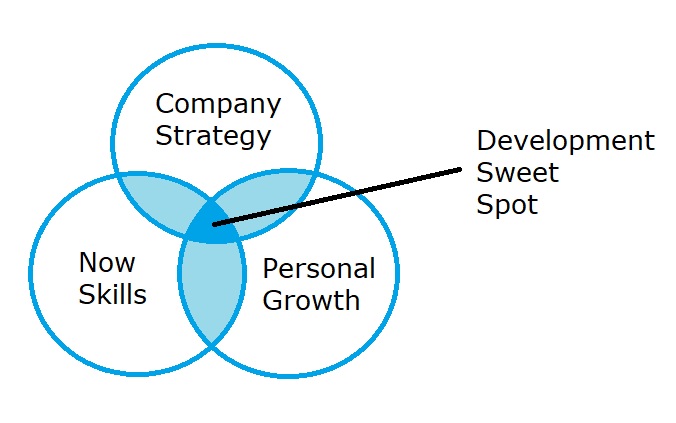Objectives are specific results that you or your team wish to achieve within a time frame using the resources available. These are generally more specific and easier to measure than goals as they can be both short and long term.
Objectives can be used to create policy and evaluate performance by ticking off key results. To successfully make use of objectives to up-skill staff they need to check most of these boxes:
- Align to company values and objectives
- Finite, so limited in size and scope with suggested periods of short term (3 months) or long term (6 months)
- Documented and tracked as visibility is key. This can be done with
small improvements - Continually improved upon and spoken about, this can be done in a bi-weekly catchup with your people leader / manager or chapter lead.
Objective Sweet Spot
Further to the above to be well balanced, objectives need to be in the sweet spot between the Company Strategy, your Now skills and your own Personal growth

Clarifying the objective
This is where you want to get to.
- What do you want to achieve with an ideal outcome?
- What do you want to change or improve on?
- Why this objective, what value will it bring?
- What will success look like?
- What would the benefits of achieving this objective be
- For the team / company?
- For growing your current skill set?
- For long term growth?
- Looking 6 months ahead, what would you like to see happening?
What you already bring to the table
These are existing strengths and areas you need to develop.
- What are you already doing that already contributes to this objective?
- What is going well and what are the challenges?
- What is currently in place to promote success and what affect is it having?
- What is currently in place that gets in the way of success and what affect is it having?
- Where are you right now in relation to the objective?
- What progress have you made so far?
- Which of your peers have had a similar objective that you can learn from?
- What have you already tried?
Documenting
Once you have identified the objective an approach to start documenting it and noting the key results could be to use a 70:20:10 split. This is 70% experimental, 20% social and 10% formal.
- 70% experimental, this is 7 points around the objective which include key results, technologies used and action items to help achieve the objective.
- 20 % social, this is 2 people that will help you with your objective. These can be anybody with domain knowledge around the objective. They need to know you have chosen then and be willing to help.
- 10% formal, this is training and can be lectures or formal discussions or simply online training.
The above can be visually drawn as shown below, this was an objective to build a Lexicon Manager which is used to manage a company’s copy / microcopy. This is the actual text displayed on platforms such as desktop website or native mobile phone app.

From the above the 70% experimental column shown on the left can be grouped as:
- Key Results
- Company gains an asset
- Code speak around containers
- Technologies used
- Amazon ECS
- Docker compose & Powershell
- Code repository, I released this project open source to GIT.
- Documentation
- Gathering requirements
- Actual documentation on wiki, share or presentation.